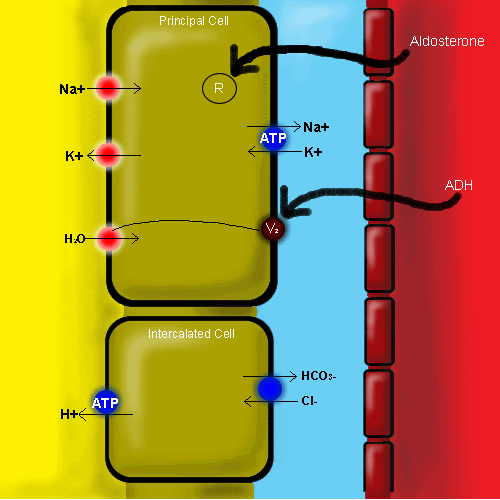|
|
Aldosterone
 Aldosterone
release is dependent upon two primary stimuli. Both an increase in
angiotensin II concentration, and an increase in plasma [K+] lead to
the release of aldosterone into the circulation. Although the half-life
of aldosterone is only twenty minutes, its action peaks about thirty
minutes after release due to the production of proteins and an increase
in the number of channels present. For a more detailed discussion of
the relationship between renin, angiotensin, and aldosterone, please
see the renin page. Aldosterone
release is dependent upon two primary stimuli. Both an increase in
angiotensin II concentration, and an increase in plasma [K+] lead to
the release of aldosterone into the circulation. Although the half-life
of aldosterone is only twenty minutes, its action peaks about thirty
minutes after release due to the production of proteins and an increase
in the number of channels present. For a more detailed discussion of
the relationship between renin, angiotensin, and aldosterone, please
see the renin page.
From this explanation of the physiological effects of renin, you should
be able to understand the consequences involved with hypo- and hyperaldosteronism.
Hypoaldosteronism will result in decreased sodium uptake in the collecting
ducts, causing a decrease in ECV. This leads to an increase in sympathetic
tone, and increased concentrations of renin, angiotensin II, and ADH.
Hyperaldosteronism will show the opposite effects.
<Back
|
 Aldosterone
release is dependent upon two primary stimuli. Both an increase in
angiotensin II concentration, and an increase in plasma [K+] lead to
the release of aldosterone into the circulation. Although the half-life
of aldosterone is only twenty minutes, its action peaks about thirty
minutes after release due to the production of proteins and an increase
in the number of channels present. For a more detailed discussion of
the relationship between renin, angiotensin, and aldosterone, please
see the renin page.
Aldosterone
release is dependent upon two primary stimuli. Both an increase in
angiotensin II concentration, and an increase in plasma [K+] lead to
the release of aldosterone into the circulation. Although the half-life
of aldosterone is only twenty minutes, its action peaks about thirty
minutes after release due to the production of proteins and an increase
in the number of channels present. For a more detailed discussion of
the relationship between renin, angiotensin, and aldosterone, please
see the renin page.